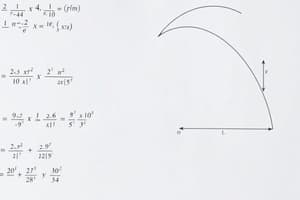Podcast
Questions and Answers
What does the variable 'a' represent in the vertex form of a quadratic function?
What does the variable 'a' represent in the vertex form of a quadratic function?
- The x-coordinate of the vertex
- The x-intercept of the function
- The width and direction of the parabola (correct)
- The y-coordinate of the vertex
In the general form of a quadratic function, what is the significance of the expression $-\frac{b}{2a}$?
In the general form of a quadratic function, what is the significance of the expression $-\frac{b}{2a}$?
- It gives the x-coordinate of the vertex. (correct)
- It indicates the axis of symmetry.
- It represents the y-intercept of the function.
- It determines the x-intercepts of the parabola.
What is the vertex of the function f(x) = 2(x + 3)² − 6?
What is the vertex of the function f(x) = 2(x + 3)² − 6?
- (0, -6)
- (3, -6)
- (-3, 0)
- (-3, -6) (correct)
Which of the following describes the axis of symmetry in the vertex form of a quadratic function?
Which of the following describes the axis of symmetry in the vertex form of a quadratic function?
How can you determine if a parabola opens upwards or downwards from the vertex form $f(x) = a(x - h)^2 + k$?
How can you determine if a parabola opens upwards or downwards from the vertex form $f(x) = a(x - h)^2 + k$?
Which form represents the function f(x) = −x² + 6x − 4 in factored form?
Which form represents the function f(x) = −x² + 6x − 4 in factored form?
What is the y-intercept of the function f(x) = (x − 4)(x − 2)?
What is the y-intercept of the function f(x) = (x − 4)(x − 2)?
In the factorized form $f(x) = a(x - p)(x - q)$, what do 'p' and 'q' represent?
In the factorized form $f(x) = a(x - p)(x - q)$, what do 'p' and 'q' represent?
What is the general form of the quadratic function f(x) = 3(x − 1)(x + 2)?
What is the general form of the quadratic function f(x) = 3(x − 1)(x + 2)?
What is the y-intercept of the quadratic function in general form $f(x) = ax^2 + bx + c$?
What is the y-intercept of the quadratic function in general form $f(x) = ax^2 + bx + c$?
Which key feature of the function f(x) = -4x² + 2x is correctly identified?
Which key feature of the function f(x) = -4x² + 2x is correctly identified?
What transformation must occur to change a quadratic function from the general form to the vertex form?
What transformation must occur to change a quadratic function from the general form to the vertex form?
Which of the following statements is true about the vertex of a quadratic function in both general and vertex forms?
Which of the following statements is true about the vertex of a quadratic function in both general and vertex forms?
For the function f(x) = -12(x - 4)² - 2, what is the vertex?
For the function f(x) = -12(x - 4)² - 2, what is the vertex?
What is the significance of a negative leading coefficient in a quadratic function such as f(x) = -x² + 6x - 4?
What is the significance of a negative leading coefficient in a quadratic function such as f(x) = -x² + 6x - 4?
Which of the following describes the coordinate of the y-intercept of the function f(x) = 2(x + 3)² − 6?
Which of the following describes the coordinate of the y-intercept of the function f(x) = 2(x + 3)² − 6?
Flashcards
Y-intercept of a quadratic function
Y-intercept of a quadratic function
The point where the parabola intersects the y-axis. This point is also where x=0.
Vertex of a quadratic function
Vertex of a quadratic function
The highest or lowest point of a parabola. It is located halfway between the x-intercepts.
Quadratic functions
Quadratic functions
A function that can be written in the form f(x) = ax^2 + bx + c, where a, b, and c are constants and a ≠ 0.
Vertex Form of a quadratic function
Vertex Form of a quadratic function
Signup and view all the flashcards
Factored Form of a quadratic function
Factored Form of a quadratic function
Signup and view all the flashcards
General Form of a quadratic function
General Form of a quadratic function
Signup and view all the flashcards
X-intercept of a quadratic function
X-intercept of a quadratic function
Signup and view all the flashcards
Conversion between different forms of a quadratic function
Conversion between different forms of a quadratic function
Signup and view all the flashcards
Vertex Form
Vertex Form
Signup and view all the flashcards
Axis of Symmetry
Axis of Symmetry
Signup and view all the flashcards
Concavity of Parabola
Concavity of Parabola
Signup and view all the flashcards
General Form
General Form
Signup and view all the flashcards
Vertex's x-coordinate
Vertex's x-coordinate
Signup and view all the flashcards
Y-Intercept
Y-Intercept
Signup and view all the flashcards
Factorized Form
Factorized Form
Signup and view all the flashcards
Axis of Symmetry (Factorized Form)
Axis of Symmetry (Factorized Form)
Signup and view all the flashcards
Study Notes
Chapter 3: Linear and Quadratic Functions
- This chapter focuses on graphing quadratic functions.
- Essential questions explore changing from general to vertex to factored form of quadratic functions.
- The study questions address how these forms identify key graph features.
Graphing Quadratic Functions (Example)
- Equation: f(x) = −0.5x² + 7.5x – 18
- Domain: All real numbers
- Range: y ≤ 1.875
- x-intercepts: Points where the graph crosses the x-axis.
- y-intercept: Point where the graph crosses the y-axis.
- Vertex: The highest or lowest point on the graph.
Vertex Form
- Written as: f(x) = a(x – h)² + k
- a, h, k are real numbers, and a ≠ 0 is important.
- a determines the parabola's direction (concave up or down).
- h and k define the vertex's position.
- The axis of symmetry is a vertical line passing through the vertex. Equation discussed.
- How to determine whether the parabola is concave up or down discussed.
General Form
- Written as: f(x) = ax² + bx + c
- a, b, and c are real numbers, and a ≠ 0 is important.
- Significance of -(c/?) and how to find vertex coordinates explained.
- y-intercept is discussed.
Factorized Form
- Written as: f(x) = a(x – p)(x – q)
- p and q are the x-intercepts
- Equation of the axis of symmetry discussed.
- Vertex coordinates discussed.
Additional Quadratic Function Examples
- Specific function examples are provided to sketch graphs.
- Label key features of the graph are requested.
Textbook Exercises
- Exercise 3L, p. 143, #1-6
- Exercise 3M, p. 149, #1-4
- Additional exercises (3N, 30) provided for further practice.
Additional Problems
- Additional quadratic problems shown. Topics include, finding factorized form of quadratic functions, calculating x and y intercept and vertices.
Studying That Suits You
Use AI to generate personalized quizzes and flashcards to suit your learning preferences.




